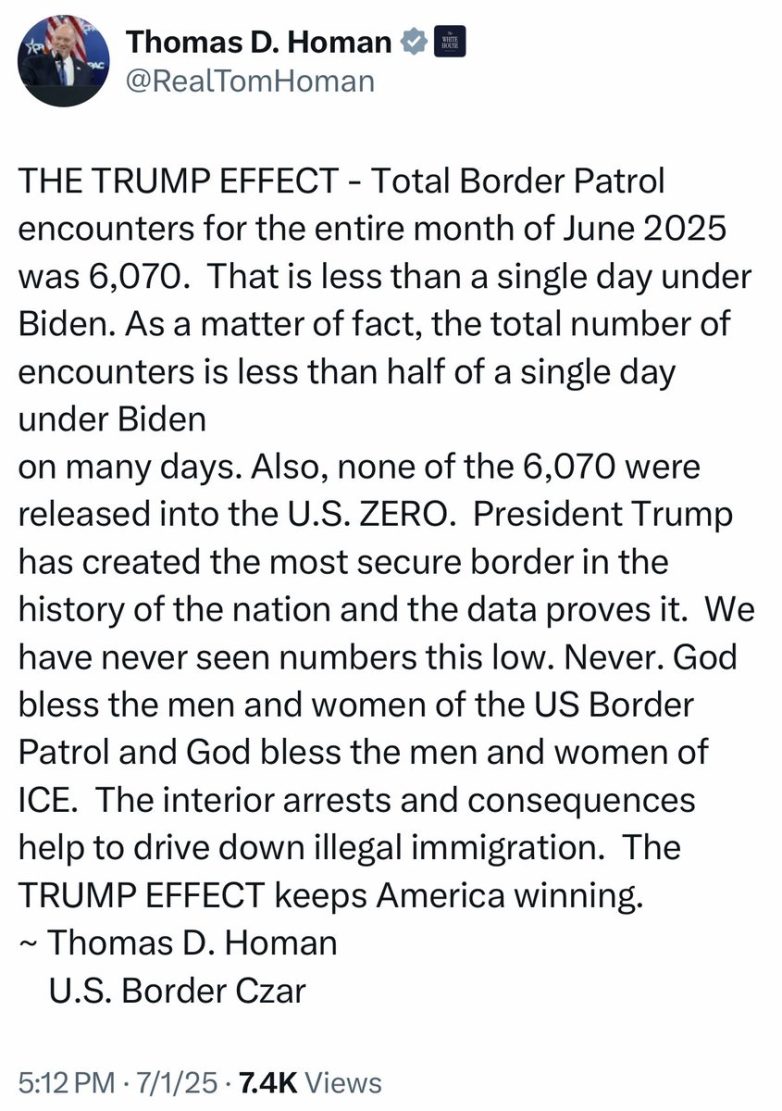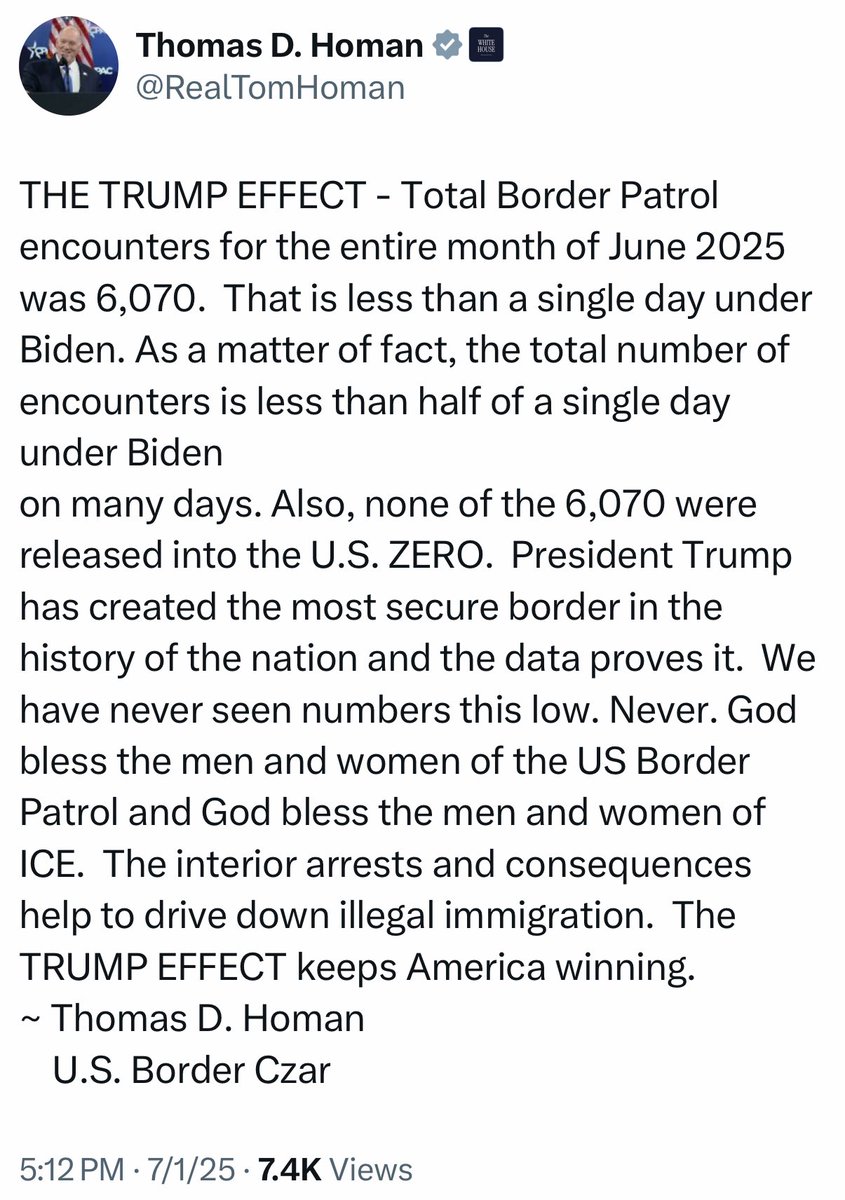
“June Border Report: No Migrants Released Again—Is This What We Wanted?”
border security policies, immigration enforcement strategies, migrant detention statistics
June Border Numbers: A Significant Shift in Migrant Releases
In a dramatic turn of events, the June border statistics have revealed that for the second consecutive month, not a single migrant was released into the United States. This announcement has sparked considerable discussion and debate, particularly among those who have been closely monitoring immigration policies and their impacts.
Understanding the Context of Migrant Releases
Historically, the release of migrants into the United States has been a contentious issue, often reflecting broader immigration strategies and policies. In recent years, the flow of migrants crossing the U.S. border has raised numerous questions about national security, humanitarian obligations, and the capacity of the U.S. immigration system. The announcement that no migrants were released in June is a significant departure from previous trends where large numbers of migrants were often allowed into the country while their cases were processed.
What This Means for U.S. Immigration Policy
The decision to halt migrant releases could be indicative of a shift in immigration policy aimed at tightening border control. This approach aligns with the sentiments expressed by some political factions advocating for stricter immigration laws and enhanced border security measures. Proponents of this stance argue that limiting migrant releases is essential for maintaining national security and reducing the strain on public resources.
Conversely, critics argue that such policies can lead to humanitarian crises, as individuals seeking asylum or refuge may face dire conditions while their cases remain unresolved. The implications of this policy shift are vast, affecting not just migrants but also local communities, law enforcement, and the overall immigration system.
Political Reactions to the June Border Numbers
The announcement has elicited a range of reactions from political leaders and advocacy groups. Supporters of the current administration’s immigration strategy have hailed the news as a victory, expressing satisfaction that the measures they voted for are being implemented effectively. This sentiment was echoed on social media platforms, where users highlighted the significance of these statistics in relation to ongoing discussions about border security and immigration reform.
On the other hand, opponents of the policy have raised concerns about the potential human rights implications. They argue that the inability to release migrants may exacerbate existing challenges within the immigration system and could lead to increased overcrowding in detention facilities. Advocacy groups are likely to continue pushing for reforms that balance national security with humanitarian considerations.
The Broader Impact on Migrants and Asylum Seekers
For many migrants and asylum seekers, the inability to gain entry into the U.S. may result in precarious living conditions, especially in situations where they are fleeing violence, persecution, or natural disasters in their home countries. The halt in releases could lead to heightened anxiety among those who are awaiting their turn to seek asylum, as they may have to navigate complex legal and logistical hurdles without the assurance of support once they arrive.
Moreover, this situation could lead to increased pressure on neighboring countries, as migrants may find themselves stranded or forced to remain in places where they are vulnerable. The international community will be watching closely to see how the U.S. balances its immigration policies with its humanitarian obligations.
Future Implications of Current Trends
As the situation continues to evolve, it will be important to monitor future border statistics and policy announcements. The absence of migrant releases may set a precedent that could influence immigration tactics in the upcoming months and years. Should this trend persist, it may lead to further discussions about comprehensive immigration reform, focusing on creating a system that effectively addresses security concerns while also protecting the rights and dignity of migrants.
Furthermore, the implications of these policies extend beyond the immediate border situation. They will likely influence public opinion, shape political campaigns, and affect the legislative agenda regarding immigration in the United States. As stakeholders on all sides advocate for their positions, the dialogue surrounding immigration policy is bound to become more intense.
Conclusion: Navigating the Future of Immigration Policy
The June border numbers reveal a pivotal moment in the ongoing conversation about immigration in the United States. The announcement that no migrants were released into the U.S. has significant implications for future policy decisions and the treatment of individuals seeking refuge. As discussions continue, it will be crucial to strive for a balanced approach that acknowledges both security needs and humanitarian responsibilities.
In summary, the recent developments in U.S. border policy, marked by the lack of migrant releases, reflect broader political dynamics and underscore the complexities inherent in immigration reform. Engaging in informed dialogue and advocating for humane solutions will be essential as the nation navigates this critical issue moving forward. The outcome of these discussions will shape the future of immigration policy and the lives of countless individuals seeking safety and opportunity in the United States.

BREAKING: June border numbers are in
For the second month in a row, NOT A SINGLE migrant was released into the U.S.
ZERO.
This is exactly what I voted for! pic.twitter.com/xwehZXFJJC
— Libs of TikTok (@libsoftiktok) July 1, 2025
Breaking: June Border Numbers Are In
June 2025 has brought us some surprising news on the immigration front. For the second consecutive month, reports indicate that NOT A SINGLE migrant was released into the U.S. That’s right—ZERO! This statement isn’t just a statistic; it reflects ongoing changes in immigration policy and public sentiment. In this article, we’ll dive into what these numbers mean, the implications for immigration policy, and how this all ties back to broader discussions happening across the nation.
Understanding the Context of the June Border Numbers
Before we discuss the implications of these zero releases, it’s essential to understand the context. The U.S. has seen fluctuating immigration policies over the past few years. The recent shift to a more restrictive approach has created waves of discussion among both supporters and critics.
When we see numbers like those reported for June, it raises questions about the effectiveness of these policies. Are they working as intended? What are the humanitarian implications? And how do these statistics align with the sentiments of voters?
The Impact of Zero Releases
So, what does it mean when we say that no migrants were released into the U.S. for two months straight?
- Policy Implications: The current administration has emphasized stricter immigration enforcement. The data suggests that these policies may be deterring migrants from attempting to cross the border. However, it also raises concerns about the conditions in which these individuals are being held while awaiting processing.
- Public Sentiment: For many who supported these policies, this outcome is a victory. They believe it reflects a commitment to border security and national sovereignty. For others, however, it raises ethical questions about the treatment of migrants, particularly those seeking asylum from dangerous situations.
- Political Ramifications: The political landscape is continually shifting, particularly with the upcoming elections. Candidates will likely use these statistics to argue for or against current immigration policies, making it a hot-button issue in campaign discussions.
The Reaction: “This is Exactly What I Voted For!”
One key aspect of this debate is the reaction from various groups. The tweet from Libs of TikTok captures a sentiment shared by many individuals who supported stricter immigration measures. For them, seeing zero releases is a validation of their vote and beliefs regarding immigration policy.
But how do these sentiments play into the larger national conversation?
Supporters of Strict Immigration Policies
For those in favor of stricter immigration, these statistics are a badge of honor. They argue that the absence of releases indicates a strong stance against illegal immigration and reflects a commitment to maintaining order at the borders. They often cite concerns about crime, resource allocation, and the integrity of legal immigration processes.
Opponents of Current Policies
On the flip side, critics argue that these policies are inhumane. The lack of releases may highlight systemic issues within the immigration system, such as overcrowding in detention centers and the prolonged detention of individuals who have fled dangerous situations. They advocate for a more compassionate approach, emphasizing the need for humane treatment of migrants and a more efficient immigration process.
The Broader Implications for Immigration Policy
The numbers from June are not just isolated data points; they reflect broader trends and challenges in immigration policy.
The Humanitarian Perspective
When we talk about immigration, it’s vital to remember the human element. Many migrants are fleeing violence, poverty, and persecution. With zero releases, we must consider the conditions in which these individuals are being held. Are they receiving adequate care? What happens to families separated at the border?
Advocates for humane immigration practices argue that a more compassionate approach could lead to better outcomes for both migrants and the U.S. as a whole. They point to successful integration stories and the contributions migrants make to society.
The Economic Considerations
From an economic standpoint, immigration has traditionally been seen as a boon to the U.S. economy. Migrants often fill essential roles in various industries, contributing to growth and innovation. With the current trend of zero releases, there could be long-term economic implications, particularly in sectors that depend on immigrant labor.
What’s Next? The Future of Immigration Policy
As we look ahead, the question remains: what will happen next with immigration policy? The June border numbers are just one piece of a larger puzzle.
Legislative Action
We may soon see calls for legislative action aimed at reforming immigration policy. Politicians from both sides of the aisle are likely to weigh in on the issue, suggesting new laws or modifications to existing policies. The outcomes could reshape the landscape of immigration for years to come.
Public Engagement
Public engagement is crucial in this debate. Citizens need to make their voices heard, whether through voting, advocacy, or community involvement. The conversation around immigration is complex and multifaceted, and everyone has a role to play.
Conclusion: A Call to Action
The June border numbers reveal a critical juncture in U.S. immigration policy. As we navigate this challenging landscape, it’s essential to consider the broader implications of these statistics—from humanitarian concerns to economic impacts.
By engaging in meaningful conversations and advocating for policies that prioritize both security and humanity, we can work toward a more effective immigration system. After all, the story of immigration in the U.S. is not just about numbers; it’s about people, families, and the future we want to build together.
For ongoing updates on immigration policy and related news, stay tuned to credible sources and engage with your local representatives. Together, we can contribute to a more informed and compassionate dialogue around this important issue.
BREAKING: June border numbers are in For the second month in a row, NOT A SINGLE migrant was released into the U.S. ZERO. This is exactly what I voted for!